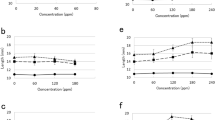Abstract
Tentative identification using HPLC and RIA techniques indicated the presence of zeatin-O-glucoside, zeatin, ribosylzeatin, dihydrozeatin, iso-pentenyladenine and iso-pentenyladenosine in the petals of carnation flowers. Dihydrozeatin is apparently responsible for most of the biological activity. Within the petals most activity was detected in the basal parts which also senesced much slower than the upper parts of the petals. Treatment with AOA extended petal longevity and reduced ethylene production. This was associated with higher cytokinin-like activity in the basal parts of the petals.
These higher levels of cytokinins were not observed in the petals of ACC treated flowers or in the detached control flowers. It is suggested that cytokinin transport and/or metabolism may play an important role in regulating ethylene production in cut carnations.
Similar content being viewed by others
References
Armstrong, DJ, Burrowns, WJ, Evans, PK and Skoog, F (1969) Isolation of cytokinins from tRNA. Biochem Biophys Res Commun 37: 451–456
Cook, D, Rasche, M and Eisinger, W (1985) Regulation of ethylene biosynthesis and action in cut carnation flower senescence by cytokinins. J Am Soc Hort Sci 110: 24–27
Cutting, JG, Lishman, AW, Van derHoven, A and Wolstenholme, BN (1983) Development of a radioimmunoassay for the cytokinin isopentenyladenosine. Crop Prod 12: 133–135
Eisinger, W (1977) Role of cytokinins in carnation flower senescence. Plant Physiol 59: 707–709
Eisinger, W (1982) Regulation of carnation flower senescence by ethylene and cytokinins. Plant Physiol 69(S): 136
Halevy, AH and Mayak, S (1981) Senescence and postharvest physiology of cut flowers—Part 2. Hortic Rev 3: 59–143
Hofman, PJ, Featonby-Smith, BC and VanStaden, J (1986) The development of ELISA and RIA cytokinin estimation and their application to a study of lunar periodicity in Ecklonia maxima (Osbeck) Papenf. J. Plant Physiol 122: 465–476
Hofman, PJ, Forsyth, C and VanStaden, J (1985) A radioimmunoassay for dihydrozeatin and dihydrozeatin riboside, and its application to a study of the in vitro metabolism of dihydrozeatin by soybean callus. J Plant Phys 121: 1–12
Mayak, S, Vaadia, Y and Dilley, DR (1977) Regulation of senescence in carnation (Dianthus caryophyllus) by ethylene: Mode of action. Plant Physiol 59: 591–593
Miller, CO (1965) Evidence for the natural occurence of zeatin and derivatives: Compounds from maize which promote cell division. Proc Natl Acad Sci USA 54: 1052–1058
Mor, Y, Halevy, AH, Spiegelstein, H and Mayak, S (1985) The site of 1-aminocyclopropane-l-carboxylic acid synthesis in senescing carnation petals. Physiol Plant 65: 196–202
Mor, Y, Spiegelstein, H and Halevy, AH (1983) Inhibition of ethylene biosynthesis in carnation petals by cytokinin. Plant Physiol 71: 541–546
Nichols, R (1977) Sites of ethylene production in the pollinated and unpollinated senescing carnation (Dianthus caryophyllus) inflorescence. Planta 135: 155–159
Ronen, M and Mayak, S (1981) Interrelationship between abscisic acid and ethylene in the control of senescence processes in carnation flowers. J Exp Bot 32: 759–765
Sacalis, J, Wulster, G and James, HW (1983) Senescence in isolated carnation petals: differential response of various petal portions to ACC and effects of uptake of exudate from excised gynoecia. Z Pflanzenphysiol 112: 7–14
VanStaden, J (1976) Seasonal changes in the cytokinin content of Ginkgo biloba leaves. Physiol Plant 38: 1–5
Van, Staden, J and Dimalla, GG (1980) The effects of silver thiosulphate preservation on the physiology of cut carnations. II. Influence on endogenous cytokinins. Z Pflanzenphysiol 99: 19–26
Thompson, JE, Mayak, S, Shinitzky, M and Halevy, AH (1982) Acceleration of membrane senescence in cut carnation flowers by treatment with ethylene. Plant Physiol 69: 859–863.
Author information
Authors and Affiliations
Rights and permissions
About this article
Cite this article
Van Staden, J., Featonby-Smith, B.C., Mayak, S. et al. Cytokinins in cut carnation flowers. II. Relationship between endogenous ethylene and cytokinin levels in the petals. Plant Growth Regul 5, 75–86 (1987). https://doi.org/10.1007/BF00024735
Received:
Revised:
Accepted:
Issue Date:
DOI: https://doi.org/10.1007/BF00024735




